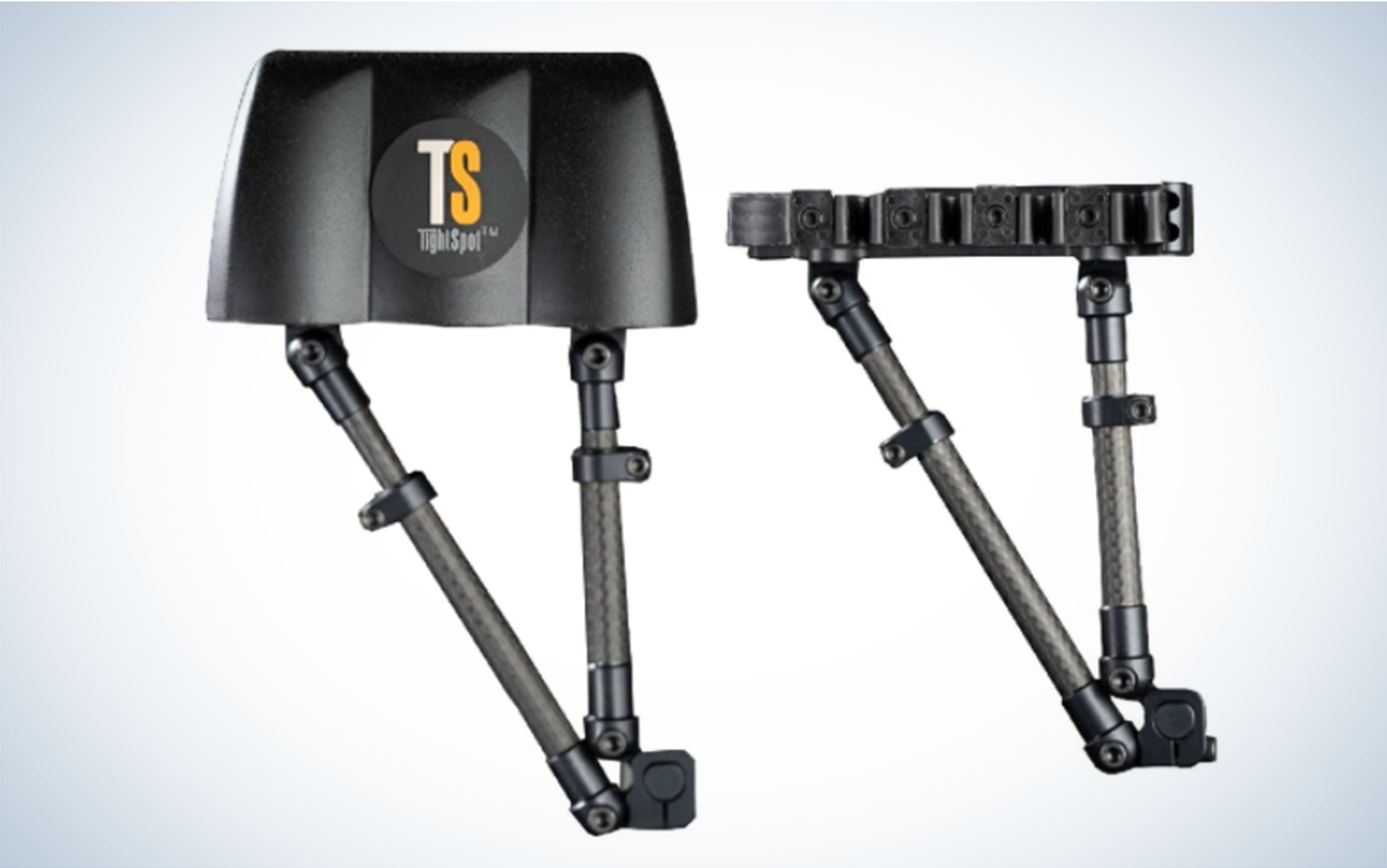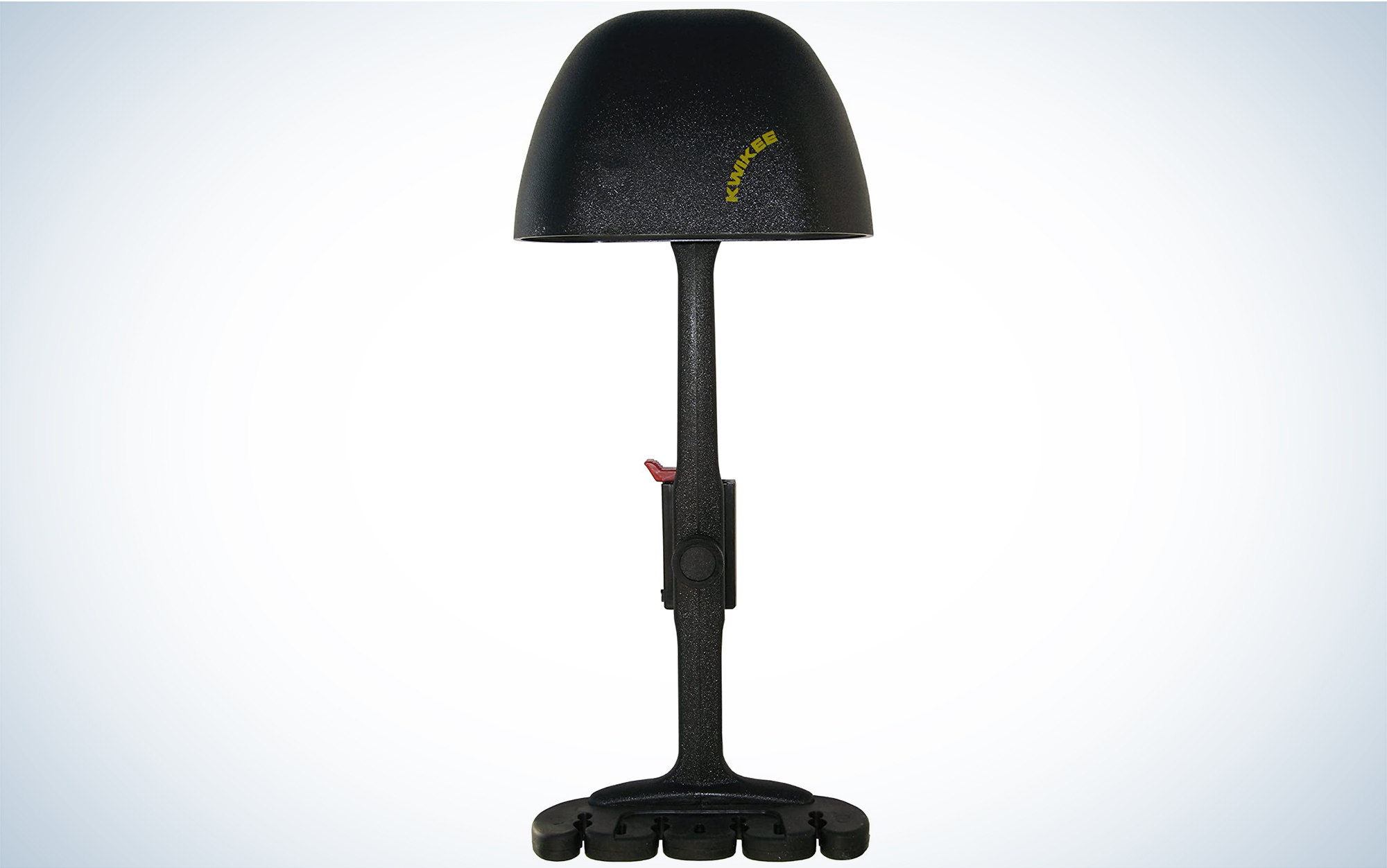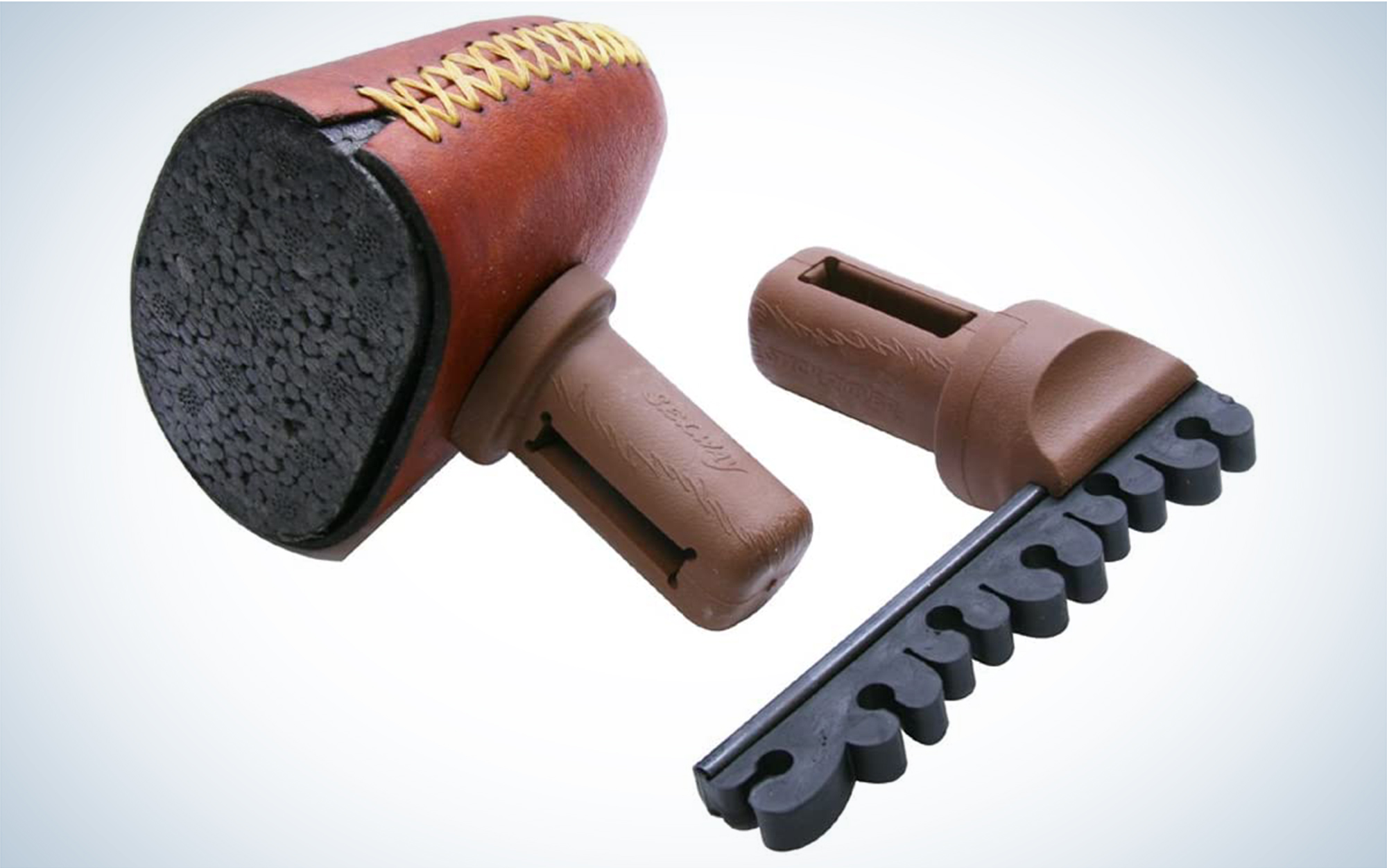We may earn revenue from the products available on this page and participate in affiliate programs. Learn More ›
Updated Jul 24, 2023 4:38 PM
The arrow quiver is one of those pieces of gear that bowhunters generally don’t think about too much. Until it’s a problem. The job of the quiver is pretty simple: carry arrows. That’s it. That’s all it does.
And often times, bowhunters simply look for the cheapest quiver they can find, or one that best matches their bow to complete a killer look. They don’t always pay attention to the working parts of the quiver that earn its keep when the heat is on.
So what do you want in a quiver? You want one that holds your arrows firmly in place, protects you from your broadheads, stays quiet, doesn’t stick out awkwardly, and, of course, looks cool.
Lancaster Archery Supply carries just about every hunting quiver on the market—certainly all the major players in the game. I get the chance to see, touch, and feel all of these quivers as they arrive in inventory, so I know them all pretty well. But in trying to find the best hunting quivers for this article, I took some extra steps to test nearly two dozen quivers.
I put arrows in the grippers and broadheads in the hoods to see how they hold. For the bow-mounted models, I mounted them on my bows to study their profiles and effect on balance, and I took shots to listen for any noise caused by vibrating parts—the coal-mine canary of bad bow quivers.
Combining that knowledge and testing, I came up with the following picks for best hunting quivers in the following categories:
The Best Bow Quivers: Reviews and Recommendations
Best Overall: Nock On Checkmate
Key Features
- 19 inches long, made of high-modulus carbon and aluminum
- Curved hood for wind deflection
- Simple, fast quick disconnect
- Holds five arrows, plus a bonus arrow
- Low-profile design
- Deep, protective hood with durable, dense rubber
- Can be adjusted up and down and left and right for perfect balance
- Holds arrows from micro-diameter up to 23 diameter
- Retractable hanging hook
Pros
- Can be used on the bow or be quickly detached
- Totally silent in all uses
- Rubber arrow gripper has separate notches to hold the skinniest arrows up to 23 diameter
- Curved hood helps cut through the wind
- Includes a one-arrow holder on the bow mount, so if you remove the quiver for hunting, you have a follow-up arrow always at the ready
Cons

The Nock On Checkmate is John Dudley’s latest contribution to the archery world. He sat down and thought about every feature he’d like to see in a quiver, and then he built that quiver.
The Checkmate is 19 inches long, and made of high-modulus carbon and aluminum. The hood is 2.5 inches deep and filled with rubber foam to hold nearly any broadhead on the market securely. Also, the hood is curved to help deflect side winds so they don’t affect the bowhunter as much as if it were flat. And it’s got a retractable ring on the back that can be pulled up for hanging the quiver in a tree stand.
The lower arrow gripper has two notches in each arrow seat to accommodate super skinny or fatter hunting arrows. One of those grippers points directly back at the archer to allow for the fast rear deployment of one of the arrows.

The bow mount features a quick-detach system. Lift a lever, and the quiver slides out. Push the quiver into the receiver and push the lever down, and the quiver is locked in place.
And that bow mount includes two arrow grippers to hold a single arrow. So let’s say you detach your quiver while hunting in a tree stand. You can load one arrow in those grippers, so you’ve always got a follow-up arrow at the ready.
The quiver can be adjusted up and down and in and out to get it to sit exactly where you want it for perfect balance on your bow.
Read Next: Best Trail Cameras
Best Budget: Octane Furnace 4-Arrow Quiver
Key Features
- Detachable, one-piece quiver
- Deep hood with thick foam for seating broadheads
- Dual arrow grippers in addition to the hood
- Quickly detaches
- Holds four arrows
Pros
- Costs less than $35
- Securely locks arrow in place with three connection points
- Adjustable height to get the quiver in the right place on your bow
- Quick-detach is fast and easy to use
- Holds arrows of varying diameters
Cons
- The foam in the hood will break up over time
- Won’t stand up to much abuse
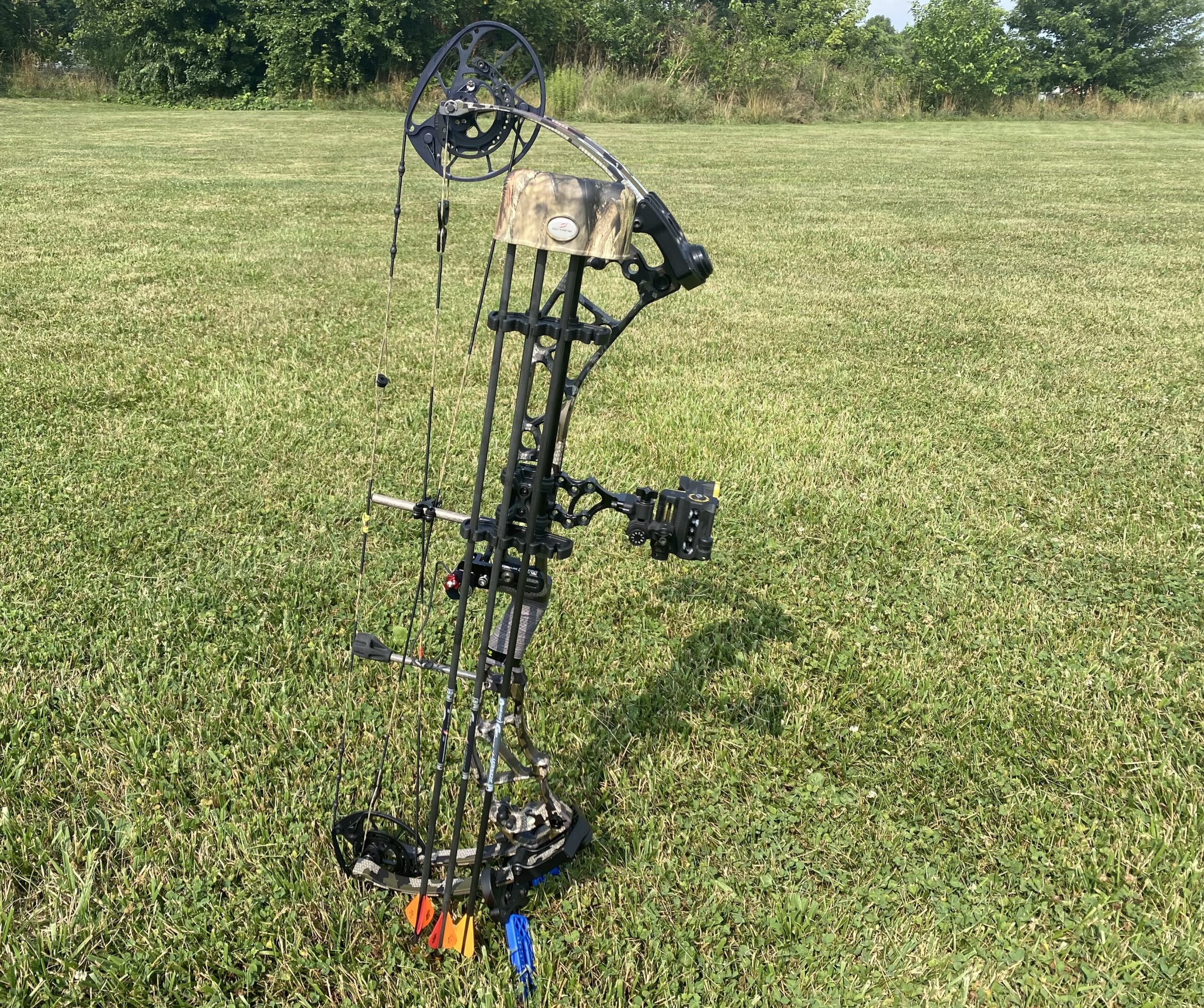
Not everyone wants to—or can afford to—spend $100 or more on a bow quiver. Some bowhunters just want the least expensive option for holding arrows securely. The Octane Furnace does that.
It’s a four-arrow quiver with two carbon rods connecting the hood to two arrow grippers. With three connection points, arrows are going to stay put. And the grippers will securely hold the most popular hunting arrow shaft sizes.
The attachment point on the quiver slides up and down so you can seat the quiver at the height you want on your bow. That connection point pops in and out of the quick-detach base that’s mounted to the bow. A lever holds the two parts together and then releases them from one another when you want to remove the quiver.
The hood is 3 inches deep and filled with foam for seating broadheads. You can remove the foam when using field points or mechanicals that you don’t want to sink into the foam.
This quiver isn’t built to handle serious abuse, which is one of the reasons it is so inexpensive. But just pay a little attention to what you do with it, and it will last for many years – especially for tree stand and ground blind hunters who simply carry their bows from the truck to their hunting sites.
Redline RL-1 Carbon Quiver 6-Arrow
Key Features
- 20 inches long, yet only weighs 9.7 ounces
- All carbon rods
- Simple, yet secure, quick disconnect
- Holds six arrows
- Low profile design
- Deep, protective hood with rubber lining and dedicated broadhead seats
- Can be adjusted so quiver top stays below top limb and arrows don’t extend beyond bottom limb
Pros
- You can slide the quiver forward or back to get it balanced on the bow
- No rattling when you carry your bow or when shooting
- Rubber arrow gripper holds shafts securely
- Long design is great for securing arrows to the bow
- Quick disconnect is fast and easy
Cons
- The dedicated seats for broadheads are great for expandables and three-blade fixed broadheads, but they’re not ideal for broadheads with two large blades.
The Redline RL-1 Carbon Quiver is a six-arrow quiver measuring 20 inches long, but only weighing 9.7 ounces, thanks to all the carbon in its construction. There’s an identical, 3-arrow version that weighs 6.5 ounces if you want to cut even more weight. Redline is a new player in the compound accessory market, but the people behind the company have tons of experience. This quiver is a great example of the Redline goal, which is to produce quality gear at a fair price. This quiver isn’t cheap, but it’s not over-the-top expensive either.

The long design is a fairly new trend in quivers. I like it. With arrow shafts secured in grippers in the lower third and at the tip, they feel more secure than when you’re using a shorter quiver that grips them in the upper half of the shafts.
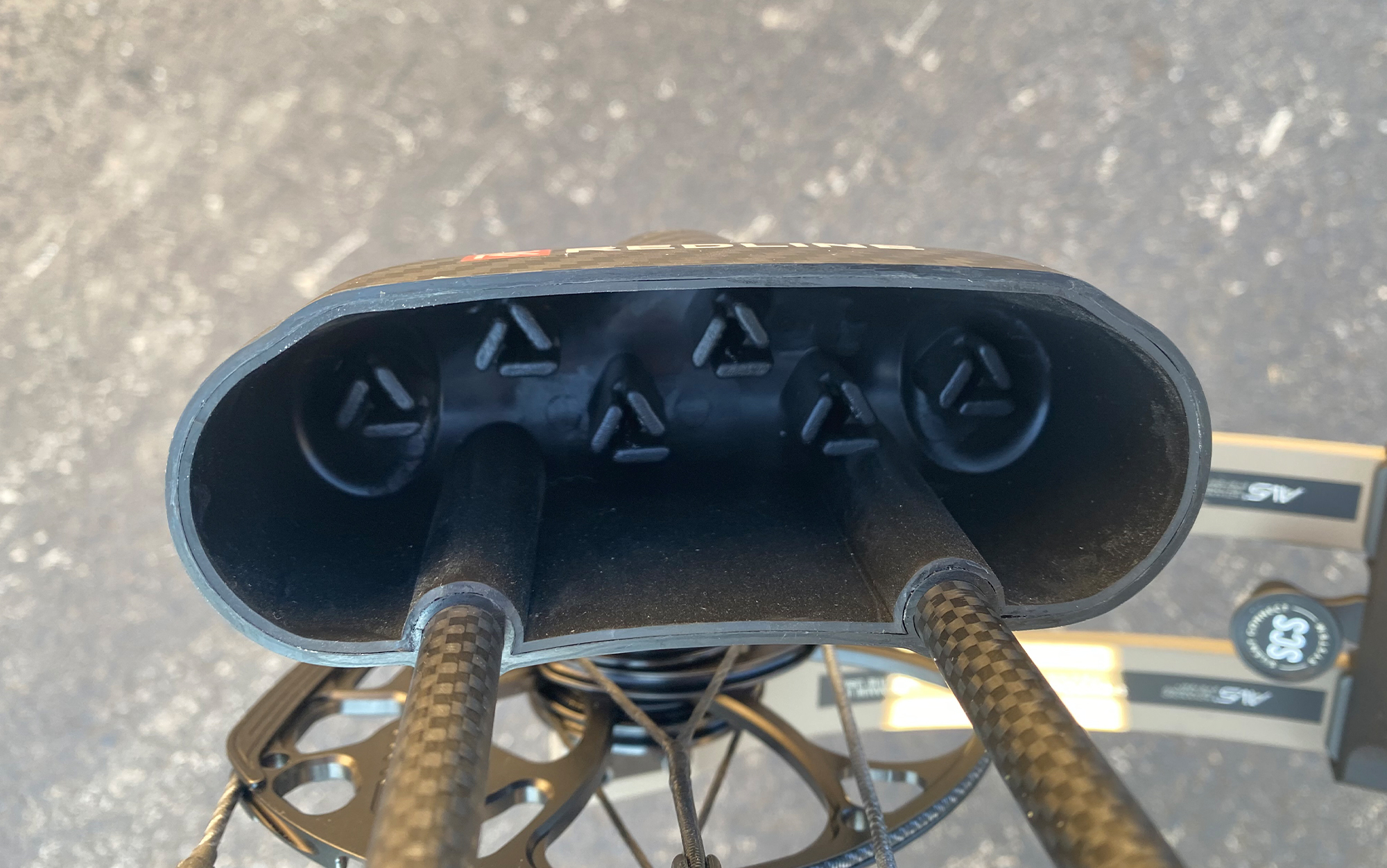
The RL-1 has great rubber broadhead seats inside the hood that work well with any expandables and with three-blade, fixed heads. As I mentioned, big two-blade fixed heads won’t sit as neatly, but they’ll still be secured.


If you want to take the quiver off when you’re up in the tree stand, there’s a simple, metal lever that you raise about 3 inches and then you slide the quiver straight back. It’s super secure and super quiet.

The features of this quiver are all great, but it vaulted to the top of my list when I put it on my Mathews V3X 33 and shot with it attached. It was whisper quiet, which is important. But what I didn’t expect was how well it allowed me to hold the bow. I was rock steady with the RL-1 on my bow with 4 arrows in the quiver. I held even steadier with it on than I did with it off. I’m sure it’s because I was able to slide the quiver straight back toward me. With a slotted mounting bracket, you can pull this quiver back toward you a good bit farther than you can basically any other quiver. So instead of it sitting parallel to the riser, it can sit parallel to the cables and string.
So the RL-1 is a well-made, lightweight, quiet quiver that holds arrows securely, and can be quickly detached, or balances the bow nicely if you choose to shoot with it on. That’s the quiver grand slam.
Key Features
- Unique, spring-loaded claws grip the mounting bracket
- Considered a five-arrow quiver, but it’s got two extra spots on the back side that allow storage of two more for a seven-arrow total capacity
- Rubber lining in the hood
- Grips arrow shafts in two places, and has point seats in the hood
- Comes with two sets of arrow grippers—one for standard hunting arrows and one for micro-diameter
- Rope tree-loop on the top for hanging in the stand
Pros
- The claw that you squeeze to remove the quiver is unique and ridiculously easy to maneuver
- Ridiculously lightweight
- Dual shaft grippers hold arrows still and quiet at the shot
- Adjustable up and down to get your arrows where you want them on the bow
- Holds seven arrows
- Costs under $90
Cons
- The point seats in the hood are round rubber cups, which I’m not a big fan of for holding broadheads
The Conquest Talon is the only quiver made by Conquest Archery, which is known more for its stabilizers. It’s lightweight, at just 9 ounces, and features dual, rubber shaft grippers, which is unusual for a 13-inch quiver. But those 2 grippers—plus the point seats inside the hood—ensure your arrow isn’t going anywhere until you pull one out.
You can adjust the quiver up and down on the twin, carbon support rods, and then lock it in place so it stays put where you want it. But the main feature of this quiver is the quick disconnect. No other quiver on the market has a disconnect like the Talon.

Essentially, it’s a claw that grabs hold of the mounting block on the riser. The claws are held in place by spring-loaded arms. Squeeze those arms and the claws release the mount block. You can easily pluck this quiver off the bow with one hand in a second.
To be perfectly honest, the Conquest Talon wasn’t on my radar as I was doing my initial research for this article. I had done a video on it two years ago when it came out and hadn’t paid much attention to it since. I saw it in the Lancaster Archery Supply Pro Shop and remembered the unique, quick-disconnect.

At first glance, it seems like there’s no way the quiver claw that grabs the mounting block would have enough force to keep the quiver from rattling. But it does. And the quick disconnect operates simpler and faster than any other I tested.
Best Fixed: TightSpot Pivot 2.5 2-piece
Key Features
- Broadhead hood and arrow gripper are two separate pieces that are attached individually to the bow
- Multiple included connectors fit just about any compound bow
- Pivoting rods that allow the quiver to transform so it’s always vertical, regardless of the bow
- Screw-in arrow blocks that allow the individual arrow grippers to adjust for fat or skinny arrows
- Durable, solid foam block in the hood secures fixed or mechanical broadheads
- Holds five arrows
Pros
- Can be adjusted to fit nearly all compound bows
- Once set and fitted with arrows, it’s solid
- No audible extra noise added to the bow at the shot
- Hood foam is deep and locks broadheads in place
Cons
- I couldn’t tighten the bolt enough on the lower half of my test quiver to solidly lock down that piece. Once arrows were in it, however, it didn’t move.
The TightSpot Pivot 2.5 2-Piece Quiver is an adjustable quiver that can be permanently attached to just about any compound bow in a variety of configurations. Some bowhunters prefer quivers that are not detachable, because the quivers designed to attach and detach often are the ones prone to rattle when walking and shooting.

The top half—hood—and the bottom half—arrow gripper—of this quiver are bolted onto the riser of a bow independently. TightSpot includes multiple hardware pieces to match the varying connection points across the spectrum of compound bows on the market. Once attached to the riser, the Pivot earns its name from the adjustable rods that can be maneuvered so the quiver stands vertically on any bow. And the rods telescope so you can extend or reduce the distance between the gripper and the hood. You can also push the quiver in toward the riser to produce a slim profile, or pull it out away if you need to work around other accessories.
Screws mounted in rubber wedges between the individual arrow grippers can be driven in, or backed out, which compresses or opens the grippers to accommodate arrows of different diameters. With the wedges screwed all the way in, they’ll firmly hold 4mm shafts. Backed out, you can load 23-diameter shafts without a problem.
The soft foam that fills the hood is my favorite kind of foam for broadheads. No, it isn’t as durable as harder rubber seats in the hoods of other quivers, but it holds broadheads in place better than any other material. And as long as you seat your broadheads in the same holes in the foam every time you load your quiver, the foam will last for many years.
Key Features
- Detachable, one-piece quiver
- Deep hood with thin, solid rubber padding inside and guide holes for arrow tips
- Strong arrow gripper will hold skinny and normal diameter hunting arrows
- Can be locked in with an included bolt
- Lightweight at 8.4 ounces
- Holds four arrows
Pros
- Costs $30
- With the Ultra-Lock bolt in place, it’s super quiet
- Actic-2 arrow holder remains pliable in freezing weather
- Easily detaches without the Ultra-Lock bolt
- Even large fixed-blade broadheads are totally enclosed in the hood
Cons
- Without the Ultra-Lock bolt, it has a faint rattle
- With the bolt in place, detaching is not as fast as without it
- Arrows extend below the bottom cam
The Kwikee Kwiver Lite-4 was going to make my list somehow because it’s one of the rare pieces of compound bow equipment that has remained virtually unchanged for more than three decades. I can think of no other piece of compound gear that hasn’t morphed over the years to change the way it functions or the way it looks. With that kind of longevity without transformation, you know The Kwikee Kwiver Lite-4 works.
This is a one-piece, detachable quiver that holds four arrows. Arrows are held about a third of the way down the shaft by the rubber Arctic 2 gripper, which doesn’t turn to rock when it’s cold outside.
The hood has a thin, solid-rubber lining with guide holes in the top to receive arrow points. Those holes combined with the gripper hold arrows pretty snugly in place.
The quick-detach bracket employed by the Kwikee Lite-4 is the same as it’s always been. There’s a metal leaf with a red plastic top that you pull back to insert the quiver. When the quiver is seated, the leaf springs back into place and the red top then holds the quiver down.
To get the quiver completely silent, you’ll need the Ultra-Lock bolt, which mounts through the center of the quiver arm and pins it to the bracket. It’s easy enough to unscrew it to detach the quiver, but it takes extra time. Without that bolt, the quiver does rattle a bit at the shot.

Where the Kwikee Lite-4 sits on the riser is both good and bad. The quiver sits kind of in the middle of the bow, while others usually sit higher. This lower position causes arrows 27 inches and longer to extend below the bottom cam on most bows, which means the nocks are constantly digging into the dirt if you rest your bow on the bottom cam. But that low position allows your bow to balance better during a shot. It doesn’t make the bow top heavy, like some other quivers.
Key Features
- Two-piece design
- Slides over limbs
- Hood is solid leather with thick, trad stitching
- Foam insert inside the hood is deep to receive those big traditional broadheads
- Lower, rubber gripper securely holds five arrows
- Fits recurve bows with limbs 1.5-2 inches wide
Pros
- Can be adjusted up and down on the limbs to hold arrows of any length
- The ends twist to get the orientation of both halves so they hold arrows parallel to the bow
- Easy to install
- Looks super traditional
Cons
- Not the most secure-fitting quiver
The Selway Slide-On Recurve Quiver tells you exactly what it is in the name. It’s a two-piece quiver that slides onto recurve bows. Each half slides onto a limb.


Assembly is simple. Remove the bowstring and slide the hood over the upper limb tip and down toward the riser. Slide the arrow gripper over the lower limb tip and up toward the riser. Position the two halves anywhere to hold your arrows accordingly. The two pieces fit fairly snugly, so long as the limbs are 1.5-2 inches wide. Of course, they fit the 2-inch limbs more snugly than the 1.5-inch.

The hand-stitched leather hood is what makes this quiver so trad. It looks cool and forms the perfect container for my favorite broadhead-holding foam. Stuff a big, 135-grain Zwickey two-blade into this foam and it’s not going anywhere, nor is it cutting anyone accidentally.
With its all-rubber contact points, the Selway is nice and quiet on the bow at the shot. Even though it might be a bit loose on the limbs as compared to a bolt-on quiver, there’s nothing metal to rattle and make noise.
Having arrows in the quiver actually makes it more secure on the bow because arrows connect the halves to one another. And it holds those arrows within easy reach in case a follow-up shot is needed fast—a not-so-infrequent issue traditional bowhunters face.
Like I said. The Selway Slide-On functions great. What seals its crown as the best traditional quiver is its looks. It’s trad through and through.
Why It Made the Cut
It’s one of the only hip quivers designed to hold broadheads left on the market. It’s well made, looks good and has my favorite type of broadhead foam.
Key Features
- Stunning leather construction
- Sturdy rubber arrow grippers
- Thick hood foam to secure broadheads
- Belt loop
- Intended for wearing only on the right side
- Leather thigh lashes
Pros
- Stows arrows right on your hip for quick loading into your bow
- Leather construction and foam in the hood protect you from razor-sharp broadheads
- Lashed to your thigh, the quiver moves with your leg as you stalk
- Rubber shaft grippers hold arrows securely
Cons
- Not ideal for tree stand or ground blind hunting
- Arrows are more exposed to brush while stalking and can get pried out of the quiver easier than arrows attached to a bow
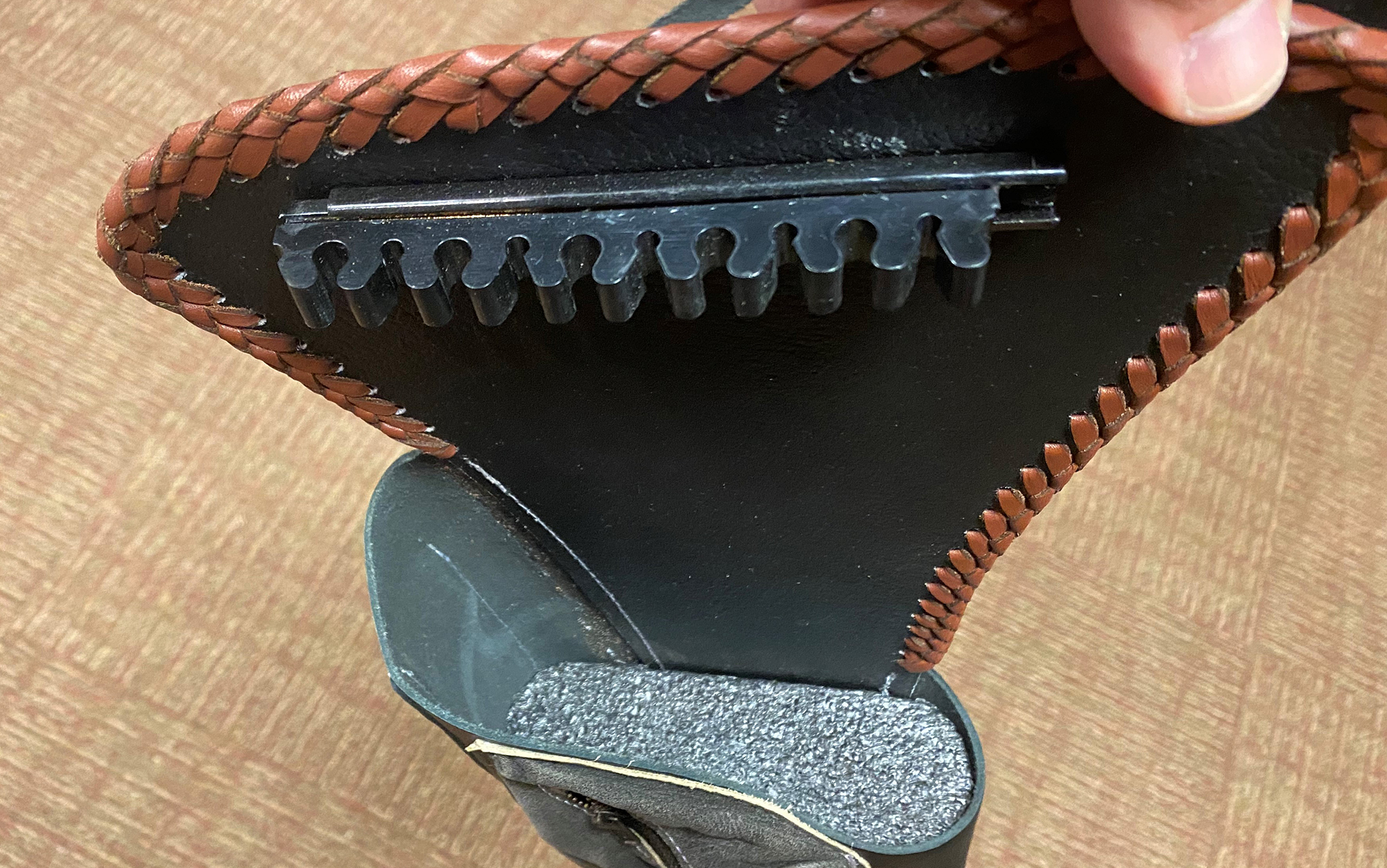
The Vista Knight Hunting Quiver is a stylish, leather quiver that holds five arrows. It’s 12 inches long by 8.5 inches across and has a loop that connects to a belt worn around your waist. It’s also got leather lashes so you can tie the bottom of the quiver to your thigh. The arrow shafts are held in place by rubber grippers at the top, while the broadhead-tipped points are buried in thick foam inside the hood.
That foam inside the hood is what separates the Vista Knight from most other hip quivers on the market. Those are designed primarily for arrows tipped with field points, and therefore intended more so for target archery than hunting. Such quivers are no good for broadheads.
Hip quivers used to be quite popular among bowhunters many years ago, but have fallen out of favor in more recent times. That’s probably why there are very few options for hunting hip quivers today. Now, you’re probably most likely to see traditional archers using such a quiver.
But they’re great for spot and stalk hunts. With the lashes tied to your thigh, this quiver moves with your body, holding arrows ready for action right on your hip, sort of like a Western six-shooter. If you have to crawl on your belly, you undo the lashes and shove the quiver around your belt to your back.
Mathews and Hoyt Quivers
Mathews and Hoyt are two bow manufacturers that have cultivated dedicated fan bases that love to fly the manufacturers’ flags. Die-hard Mathews and Hoyt owners will have as many Mathews and Hoyt accessories on their bows as they can get, including quivers. If you’re part of this crowd and you have a Mathews Phase 4, you’re just not going to put a Redline or TighSpot quiver on your bow, even though they will fit.
Fortunately for Mathews and Hoyt owners, their manufacturers both make quality quivers. We are giving them their own category because these quivers only fit the bows they’re named for. So they’re no good to owners of bows that don’t say “Mathews” or “Hoyt.” But if your bow does bear one of those names, these are the quivers for you.
Mathews LowPro Detachable Quiver
The LowPro is a five-arrow, quick-detach quiver that follows the Mathews’s overall bow design of creating a skinny bow profile. They’ve got the integrate rest mount and the Bridge-Lock cutouts for mounting a sight and stabilizer – all in the name of slimming down the bow. So they need a quiver that keeps that vibe going.

The LowPro features a single carbon rod and attaches to the bow via connections at the top of the quiver and the bottom. A simple press lever at the bottom locks it in place. Lift the lever, and the quiver easily detaches.
The hood is deep and filled with a pliable foam that holds broadheads firmly. And with the hood and lower arrow gripper 20 inches apart, the quiver holds arrows in place more securely and quietly than shorter quivers. You can set your bow on the ground – quiver side down – and not worry about arrows bending or breaking.
It’s a quiver that’s quiet, very functional, low profile, and which will appeal to the Mathews fans who just gotta have all the Mathews accessories.
Read Next: Mathews Phase 4 Review
The Arrow Web isn’t Mathews’ latest quiver, but it is the quiver that will fit the most Mathews bows. And it’s been around for many years because it’s well-made. Available in four-arrow or six-arrow versions, the Arrow Web mounts to Mathews bows via a one-of-a-kind connection.
There’s a metal piece shaped like the letter “C” that gets bolted to a unique-shaped recess built into Mathews risers. The quiver then has two metal posts on it. The top one gets seated in a cup on the mounting bracket and the lower one pivots over a raised finger before seating into its own cup.
Now that connection keeps the quiver seated solidly. It, plus harmonic dampeners in the quiver and the mounting bracket keep this quiver ultra-quiet if you choose to shoot with it attached to the bow. But if you press down on that finger on the lower attachment point on the bracket, the quiver can quickly be detached if you like to remove it in the tree stand or ground blind.
The hood space is generous and it’s filled with a rubbery pad that broadheads sink into for nearly total encasement. The arrow grippers easily accommodate standard or micro diameter hunting arrows.
The Carbon Superlite Stretch is another one of those long quivers, measuring 20 inches. Again, I like that length for stability holding the arrows in place. You can shoot your bow with this quiver attached, or it can quickly be detached at its two mounting points.
The unique feature of the Carbon Superlite Stretch is its adjustability. You can adjust the quiver up or down so the arrows sit on your bow the way you want. And you can also adjust it toward or away from the riser to navigate around other accessories. And if you’re using a Hoyt integrate arrow rest and the Hoyt picatinny mount for your sight, you can pull the Carbon Superlite Stretch insanely tight against the riser for an extremely low profile.
What to Consider When Buying a Quiver
Choosing a hunting quiver doesn’t need to be a long, drawn-out process. If you do your homework and know what you want, you should be able to pick one out in short order.
The process starts with deciding if you want the quiver to be detachable or not. Think how you hunt and where you hunt, and that decision should be simple. Of course, if you’re not sure, then go with detachable, because you can always simply leave that quiver attached.
Study how different quivers attach to a bow. If there’s going to be noise, this is where it’s going to start. You want the connection to be snug—immovable if possible.
If the quiver is detachable, how does the detach system work? You might be detaching and attaching in the dark, so you don’t want a quiver that requires fine motor skills to put it on or take it off your bow.
Like you’d do buying a car, look under the hood. How does a certain quiver hold arrow points? You want your points held firmly in place to keep them from rattling loose. In my opinion, hoods filled with foam/rubber are the most secure.
Check the arrow grippers. You want them to be pliable, so arrows can slip in and out easily, but you don’t want them to be flimsy, or the arrows will vibrate loose. Pliable, sturdy arrow grippers are best.
Overall, how well does the quiver hold your arrows? If you hold a quiver that locks arrows in place and one that allows them to move around, you will feel the difference.
Choose the quiver that holds the number of arrows you want to take with you on bowhunts and fits your budget, and you’re all set.
FAQs
Q: What arrow capacity is best for a quiver?
There are quivers out there that hold two arrows and quivers that hold 10, believe it or not. The two-arrow quiver is going to be super light. The 10-arrow quiver is certain to have some heft. Arrows are the bowhunter’s ammunition. Ideally, you’ll only need one arrow to close the deal on a bowhunt. But it’s always good to have backups. And if you’re on a hunt where multiple species are fair game, you want to be prepared for the best-case scenario of filling all your tags in a single outing. Or if you’re heading to the backcountry for a week, you want to have plenty of ammunition to get you through the week, in case your shooting isn’t on point.
Realistically, I can recall five hunts in 30 years of bowhunting where I used two or more arrows. There was one time when I used all five. I got the buck. Don’t ask why I needed five shots. How many arrows do you need to carry to feel prepared? How much weight are you willing to haul on your bow to achieve that feeling? Answer those questions and you can pick your quiver capacity.
Q: Fixed or detachable?
After arrow capacity, this is probably the leading question bowhunters have when considering a new quiver. It’s your choice, but here are the relevant factors pertaining to each type.
Fixed-position quivers are generally going to be sturdier when mounted on the bow than detachables. That might be important if you tend to be rough with your bows, or if you’re stalking through heavy cover. Fixed quivers tend to be quieter when shooting because they aren’t made to be removed. But that was more evident 20 years ago than it is today. There are some seriously quiet detachables made today.
With fixed-position quivers, you need to get used to having that weight on the bow while shooting. If you practice all year without a quiver on, and then attach one the day before hunting season, the weight change will be abrupt.
Detachables are generally associated with tree stand and ground blind hunting, because those bowhunters get to a spot and then don’t move. You can take your quiver off the bow, and still have arrows within quick reach.
Q: How much do quivers cost?
Hunting quivers range in cost from $20 up to $250. Generally, you can count on the higher-end quivers to be quieter, sturdier and lighter.
Remember, the job of a quiver is simple. It carries your arrows. But when it doesn’t do that job correctly or quietly, you’ll curse it. Consider that when you weigh how much you want to spend.
Final Thoughts
Bowhunting quivers aren’t sexy. They aren’t meant to be sexy. You don’t usually hear bowhunters waxing poetic about how much they love their quiver. You want it to do its job and never have to think about it. Pick the right one, and that’s exactly what you’ll get.




